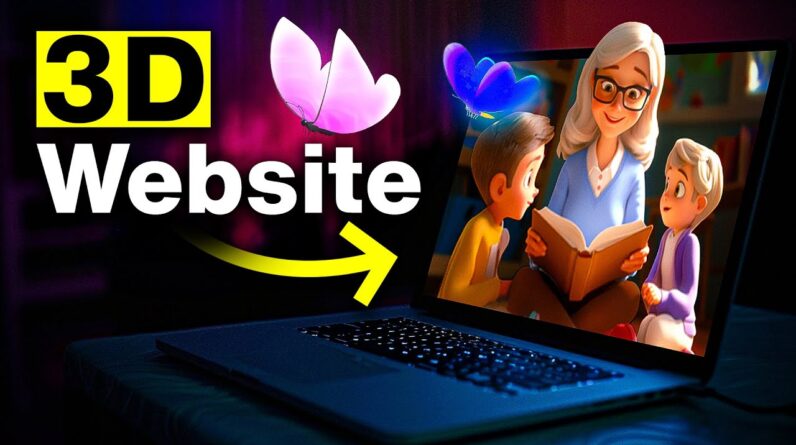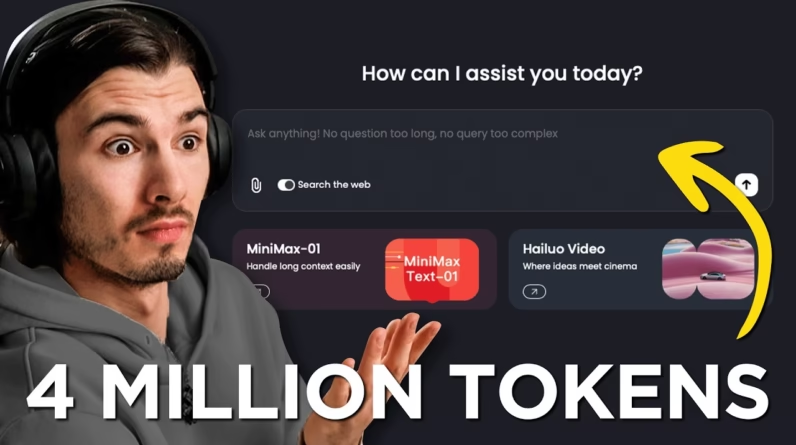
Creating a stunning website doesn’t have to be a daunting task, especially with the right tools at your disposal. This guide details how you can leverage no-code platforms and AI technologies to build a beautiful 3D website quickly, just like Christian Peverelli did for Teacher Ali’s children’s book. By utilizing the power of freelancers, you can delegate key tasks while still bringing your unique vision to life.
The article will walk you through the entire process, from hiring skilled freelancers on platforms like Upwork to using tools such as Webflow and MidJourney for design and animation. You’ll learn about the challenges that may arise along the way and how to effectively communicate with your freelancers to ensure a smooth workflow and an exciting final product. Whether you’re just starting out or looking to enhance your skills, this guide provides all the essential steps to create your very own amazing website without writing a single line of code.
Table of Contents
Understanding No-Code Development

Definition of No-Code Development
No-code development refers to the practice of creating applications and websites without the need for traditional coding. Instead of writing complex code, you can use visual interfaces, drag-and-drop features, and user-friendly tools to construct your digital projects. This approach empowers you to bring your ideas to life more swiftly and easily, often without needing prior programming knowledge. Platforms designed for no-code development provide the means to build everything from simple landing pages to complex web applications.
Benefits of No-Code Approaches
There are numerous advantages to adopting a no-code development approach. First and foremost, it drastically reduces the time it takes to develop an application or website. This efficiency allows you to focus on creativity and innovation rather than getting bogged down in technical details. Furthermore, it lowers the barrier for entry to tech-related projects, enabling individuals without a coding background to participate fully. Additionally, no-code solutions are often more cost-effective, as you’re able to bypass hiring expensive developers for every small change or project.
Common Use Cases for No-Code Platforms
No-code platforms are versatile and can serve various needs. Some common use cases include creating websites for businesses or personal projects, developing internal tools or dashboards for startups, and building MVPs (Minimum Viable Products) to test market ideas quickly. You might also find no-code solutions being used in marketing to automate processes, design landing pages for campaigns, or create engaging content without needing extensive programming skills.
Top No-Code Platforms of 2024
Overview of Popular No-Code Platforms
As no-code development continues to gain momentum, several platforms stand out in 2024 for their capabilities and user-friendliness. In this landscape, you’ll find Webflow, Bubble, Adalo, and Glide leading the charge. Each of these platforms offers unique features tailored to different aspects of website and application creation, allowing you to pick one that aligns best with your specific needs.
Feature Comparisons: Webflow, Bubble, Adalo, Glide
-
Webflow: Primarily focused on website design, Webflow allows you to create stunning responsive sites with advanced design controls. It’s perfect for those who prioritize pixel-perfect design without writing a line of code.
-
Bubble: Bubble caters to more complex web applications, offering a powerful database capacity along with visual programming. It’s suited for users who need extensive functionalities and customization options beyond simple site creation.
-
Adalo: Built specifically for mobile app development, Adalo simplifies the app-building process, helping you create functional mobile applications with easy-to-use design tools. If your focus is on mobile-first solutions, Adalo is a compelling choice.
-
Glide: Glide transforms spreadsheets into applications, making it easier to create user-friendly applications quickly. It’s fantastic for those looking to manage data-driven projects effortlessly.
Advantages and Disadvantages of Each Platform
-
Webflow
- Advantages: Intuitive design capabilities, responsive layouts, strong SEO features.
- Disadvantages: Steeper learning curve for non-designers, can be more expensive than other options.
-
Bubble
- Advantages: Highly customizable applications, extensive plugin ecosystem, strong community support.
- Disadvantages: Might overwhelm beginners, performance can decrease with overly complex applications.
-
Adalo
- Advantages: User-friendly mobile app builder, rapid prototyping abilities, great for non-coders.
- Disadvantages: Limited features for complex backend functionalities, may require workarounds for advanced logic.
-
Glide
- Advantages: Fast and straightforward from data to app, great for simple, data-driven projects.
- Disadvantages: Does not support multi-user functionalities well for larger applications, basic design options compared to others.
Choosing the Right No-Code Platform
Assessing Project Requirements
To choose the most suitable no-code platform, it’s essential to begin by clearly assessing your project requirements. Are you building a marketing website, a complex web application, or a mobile app? Understanding what you need in terms of functionality, design, and user experience will guide you toward the platform that can best meet those needs.
Evaluating Budget Considerations
Budget proves to be a significant factor when selecting a no-code platform. Each platform has its pricing model, which may include subscription fees, additional costs for extra features, and charges for exceeding limits on users or functionalities. Analyze your budget constraints and anticipate future needs, so you choose a platform that not only fits your current budget but can also grow with you.
Understanding User Experience and Support Options
Lastly, you want to ensure a smooth user experience while utilizing the no-code platform. This includes the learning curve, ease of use, and the quality of customer support. Look for platforms that offer extensive documentation, tutorials, and community assistance. A responsive support team can significantly decrease frustration and increase your productivity when encountering issues.
Integrating AI Tools into Your Website
Overview of AI Tools for Web Development
Integrating AI tools into your website can enhance user experience and streamline processes. From chatbots that improve customer service to AI-driven analytics that help you understand user behavior, the potential benefits are immense. In 2024, AI tools such as MidJourney for creative visuals and platforms like Spline and Blender for animations play a crucial role in elevating website interactivity and aesthetics.
Using MidJourney for Creative Visuals
MidJourney is an AI-based image generator that provides users with the ability to create stunning visuals through simple prompts. With a focus on style and emotion, you can produce unique artwork that embodies your brand’s ethos. By integrating these visuals into your website, you amplify its overall appeal and make a memorable impression on visitors.
AI in Animations: Spline and Blender Capabilities
For those interested in incorporating dynamic elements, Spline and Blender offer powerful capabilities in animation. Spline allows for the creation of 3D designs and animations that can be easily embedded into websites, making interactive elements more engaging. Blender, while more complex, provides advanced features for crafting detailed animations, perfect for users wanting to offer a rich visual experience on their sites.
Hiring Freelancers for Web Development
Finding the Right Talent on Upwork
When embarking on a web development project, hiring freelancers can significantly alleviate your workload. Upwork is a robust platform where you can find skilled professionals across various fields. To get started, create a detailed job post that reflects your project goals and the specific skills you are looking for. Clearly outline the desired qualifications and provide examples of what you envision.
Evaluating Freelancer Proposals
Once proposals start rolling in, take your time to evaluate each one carefully. Look for freelancers who not only have the requisite skills but also demonstrate a good track record through reviews and past projects. Pay attention to their communication style and responsiveness in your preliminary discussions; it’s essential to work with someone who understands your vision and can collaborate effectively.
Effective Communication Strategies with Hired Experts
Clear communication is vital when working with freelancers. Establish a regular check-in schedule to discuss progress and provide feedback. Be specific about your expectations, timelines, and any potential concerns. Using tools like project management software can help keep everything organized and ensure that all parties are on the same page. Aim for a collaborative relationship where ideas can flow freely.
Creating a Workflow for Your Project
Defining Project Goals and Objectives
Before diving into the development process, take the time to define your project goals and objectives. This will guide your actions and decisions moving forward. What do you hope to achieve with your website or application? Are you looking to solve a specific problem, showcase a portfolio, or sell a product? Establishing these parameters will help keep your project focused and organized.
Designing Prototypes and Mockups
Creating prototypes and mockups provides a visual overview of your project’s layout and design. This phase allows you to experiment with different layouts and features without investing too much time in development. Use tools like Figma or Adobe XD to simulate user experiences, and ensure that your design aligns with your project goals before moving on to development.
Assigning Tasks and Setting Deadlines
Once your prototypes are solidified, move on to assigning tasks and setting deadlines. Break down the project into manageable components and allocate tasks according to the strengths of each team member or freelancer you’re working with. Setting clear deadlines will keep your project on track, and regular check-ins can ensure that everyone stays accountable.
Managing Challenges During Development
Identifying Common Obstacles
Even with careful planning, challenges can arise during development. Be proactive in identifying common obstacles such as scope creep, miscommunication among team members, or delays with freelancer deliverables. Recognizing potential issues early can help you develop strategies to mitigate them.
Strategies for Handling Delays and Setbacks
When facing delays, maintain a solution-focused mindset. Communicate transparently with your team about any setbacks and work collaboratively to realign on priorities. An efficient approach often involves re-evaluating timelines and adjusting scopes without sacrificing quality. Your adaptability can lead to more effective solutions and preserve morale.
Maintaining Flexibility and Adaptability in Your Project
Flexibility is key in any development endeavor. Be prepared to refine your project as feedback comes in or as market conditions change. Encouraging a culture of adaptability within your team and having the flexibility to pivot when necessary will enhance your project’s resilience and longevity.
Enhancing User Experience with Interactive Elements
Incorporating 3D Elements into Web Design
Interactivity greatly enhances user engagement on your website. Incorporating 3D elements can make your site feel more dynamic and alive. Tools like Spline and Blender allow you to integrate these features easily. Whether it’s a rotating object or an interactive background, these additions can captivate visitors and provide a memorable experience.
Utilizing Animations for a Dynamic Experience
Motion can guide users through your website, making their experience smoother and more enjoyable. Utilize animations to draw attention to important elements or transitions. Try to maintain a balance—while animations can be eye-catching, excessive movement can distract users from your main content.
Best Practices for Engaging User Interfaces
Creating an engaging user interface (UI) is crucial for retaining visitors. Keep your design clean and intuitive, ensuring that users can navigate without confusion. Use consistent visual elements, colors, and fonts to create a cohesive experience. Additionally, always prioritize performance and compatibility across various devices to maintain usability.
Finalizing Your Website
Quality Assurance and Testing Procedures
Before launching your website, don’t skip quality assurance! Conduct thorough testing to identify and rectify any bugs or performance issues. Testing should cover functionality, compatibility across devices, and user experience checks. The goal is to ensure everything operates as intended and provides a seamless experience for your users.
Gathering Feedback from Stakeholders
Inviting feedback from stakeholders brings fresh perspectives and potential improvements. Engage with potential users or collaborators to collect insights and suggestions. This dialogue can reveal preferences or concerns you might not have considered, allowing you to make informed adjustments before launching.
Launching Your Website Successfully
Finally, implement a strategic launch plan for your website. Consider building anticipation through social media teasers, email marketing, or pre-launch access for selected users. A successful launch doesn’t end with just going live; continue monitoring website performance and user engagement to ensure everything operates smoothly in the long-term.
Conclusion
Recap of Key Takeaways
In summary, navigating the world of no-code development can seem daunting initially, but the tools and strategies discussed here are designed to empower you. Remember the importance of choosing the right platform based on your needs, budgeting accordingly, and leveraging both no-code tools and AI technology to enhance your projects.
Encouragement to Explore No-Code and AI Tools
As you embark on your no-code journey, don’t hesitate to explore the abilities of AI tools to elevate your projects further. Whether it’s for visual content or animations, integrating AI can bring unique dimensions to your work that captures the essence of your vision.
Invitation to Start Your No-Code Journey
So why wait? Dive into the world of no-code and AI development today. Whether you’re building a personal project or launching a business, the opportunities are endless. With the right tools and mindset in hand, you have the power to create amazing digital experiences that resonate with your audience.







